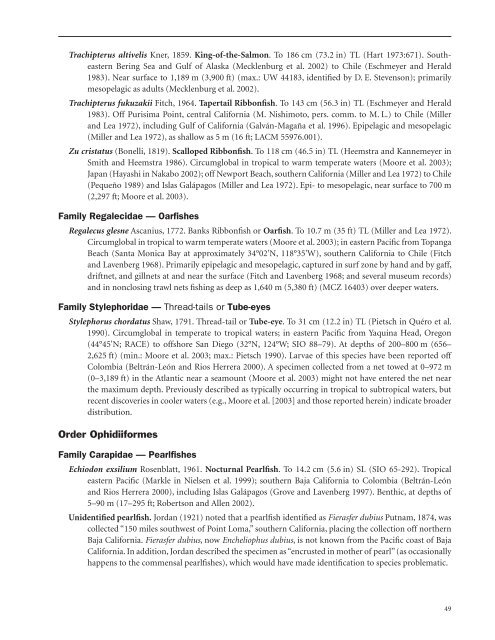Untitled - Alaska Resources Library
Untitled - Alaska Resources Library
Untitled - Alaska Resources Library
Create successful ePaper yourself
Turn your PDF publications into a flip-book with our unique Google optimized e-Paper software.
Trachipterus altivelis Kner, 1859. King-of-the-Salmon. To 186 cm (73.2 in) TL (Hart 1973:671). Southeastern<br />
Bering Sea and Gulf of <strong>Alaska</strong> (Mecklenburg et al. 2002) to Chile (Eschmeyer and Herald<br />
1983). Near surface to 1,189 m (3,900 ft) (max.: UW 44183, identified by D. E. Stevenson); primarily<br />
mesopelagic as adults (Mecklenburg et al. 2002).<br />
Trachipterus fukuzakii Fitch, 1964. Tapertail Ribbonfish. To 143 cm (56.3 in) TL (Eschmeyer and Herald<br />
1983). Off Purisima Point, central California (M. Nishimoto, pers. comm. to M. L.) to Chile (Miller<br />
and Lea 1972), including Gulf of California (Galván-Magaña et al. 1996). Epipelagic and mesopelagic<br />
(Miller and Lea 1972), as shallow as 5 m (16 ft; LACM 55976.001).<br />
Zu cristatus (Bonelli, 1819). Scalloped Ribbonfish. To 118 cm (46.5 in) TL (Heemstra and Kannemeyer in<br />
Smith and Heemstra 1986). Circumglobal in tropical to warm temperate waters (Moore et al. 2003);<br />
Japan (Hayashi in Nakabo 2002); off Newport Beach, southern California (Miller and Lea 1972) to Chile<br />
(Pequeño 1989) and Islas Galápagos (Miller and Lea 1972). Epi- to mesopelagic, near surface to 700 m<br />
(2,297 ft; Moore et al. 2003).<br />
Family Regalecidae — Oarfishes<br />
Regalecus glesne Ascanius, 1772. Banks Ribbonfish or Oarfish. To 10.7 m (35 ft) TL (Miller and Lea 1972).<br />
Circumglobal in tropical to warm temperate waters (Moore et al. 2003); in eastern Pacific from Topanga<br />
Beach (Santa Monica Bay at approximately 34°02'N, 118°35'W), southern California to Chile (Fitch<br />
and Lavenberg 1968). Primarily epipelagic and mesopelagic, captured in surf zone by hand and by gaff,<br />
driftnet, and gillnets at and near the surface (Fitch and Lavenberg 1968; and several museum records)<br />
and in nonclosing trawl nets fishing as deep as 1,640 m (5,380 ft) (MCZ 16403) over deeper waters.<br />
Family Stylephoridae — Thread-tails or Tube-eyes<br />
Stylephorus chordatus Shaw, 1791. Thread-tail or Tube-eye. To 31 cm (12.2 in) TL (Pietsch in Quéro et al.<br />
1990). Circumglobal in temperate to tropical waters; in eastern Pacific from Yaquina Head, Oregon<br />
(44°45'N; RACE) to offshore San Diego (32°N, 124°W; SIO 88–79). At depths of 200–800 m (656–<br />
2,625 ft) (min.: Moore et al. 2003; max.: Pietsch 1990). Larvae of this species have been reported off<br />
Colombia (Beltrán-León and Rios Herrera 2000). A specimen collected from a net towed at 0–972 m<br />
(0–3,189 ft) in the Atlantic near a seamount (Moore et al. 2003) might not have entered the net near<br />
the maximum depth. Previously described as typically occurring in tropical to subtropical waters, but<br />
recent discoveries in cooler waters (e.g., Moore et al. [2003] and those reported herein) indicate broader<br />
distribution.<br />
Order Ophidiiformes<br />
Family Carapidae — Pearlfishes<br />
Echiodon exsilium Rosenblatt, 1961. Nocturnal Pearlfish. To 14.2 cm (5.6 in) SL (SIO 65-292). Tropical<br />
eastern Pacific (Markle in Nielsen et al. 1999); southern Baja California to Colombia (Beltrán-León<br />
and Rios Herrera 2000), including Islas Galápagos (Grove and Lavenberg 1997). Benthic, at depths of<br />
5–90 m (17–295 ft; Robertson and Allen 2002).<br />
Unidentified pearlfish. Jordan (1921) noted that a pearlfish identified as Fierasfer dubius Putnam, 1874, was<br />
collected “150 miles southwest of Point Loma,” southern California, placing the collection off northern<br />
Baja California. Fierasfer dubius, now Encheliophus dubius, is not known from the Pacific coast of Baja<br />
California. In addition, Jordan described the specimen as “encrusted in mother of pearl” (as occasionally<br />
happens to the commensal pearlfishes), which would have made identification to species problematic.<br />
49
















